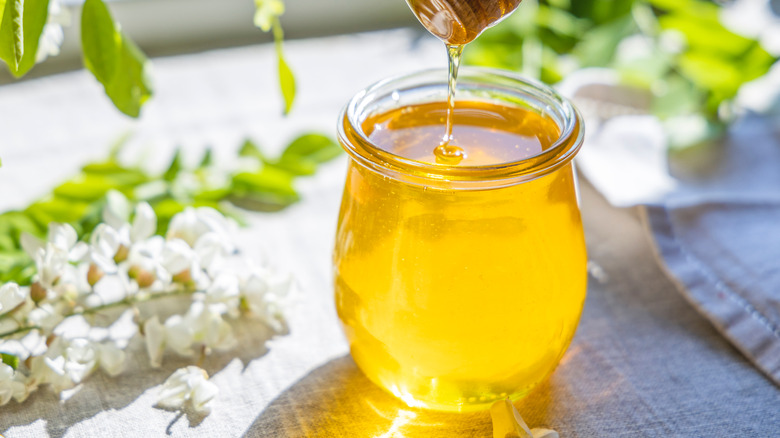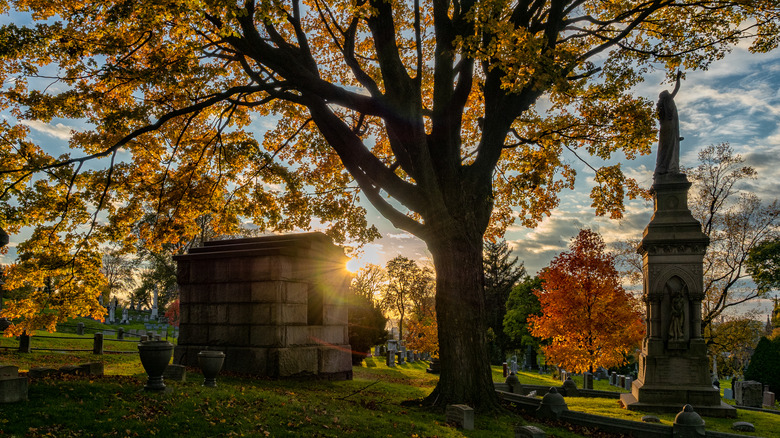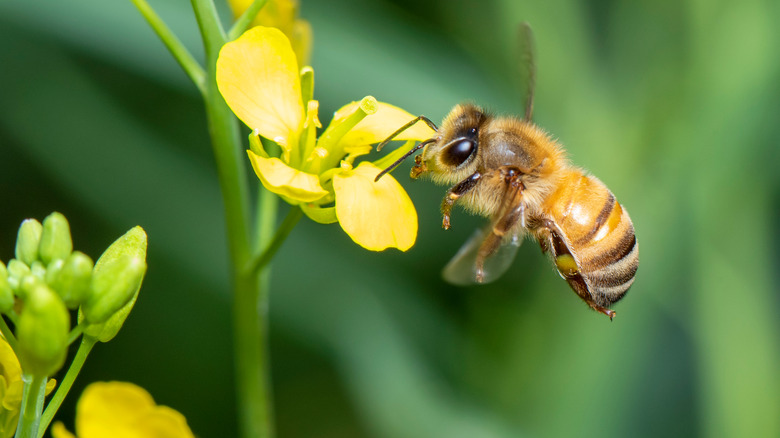The Type Of Honey That Is Exclusively Made In A Cemetery
When it comes to sweeteners, honey is in a league of its own. According to the Seattle Times, sweetness is just one component of honey's complex flavor profile, unlike sugar or corn syrup. That's because honey is imbued with unique flavors from the specific nectar that bees use to create it — and as a result, the end product can taste smoky, earthy, spicy, grassy, or even bitter.
The Natural Honey Board explains how bees are integral in producing honey in all its forms. Bees collect nectar from flowering plants; in turn, the same nectar is then transported to the hive, where it develops into honey. This process occurs as bees flap their wings, which causes nectar to evaporate and release essential sugars. Beekeepers then carefully source honey from the honeycomb, with each hive capable of producing approximately 55 pounds of excess honey on an annual basis. In addition to the knowledge and equipment required to properly care for bees, selecting the right location for the colony is equally important. That's why one enterprising beekeeper couldn't pass up a golden opportunity, albeit one in an unlikely place.
Producing a sweet product in a somber place
Nestled amid a bustling cityscape, the Brooklyn borough of New York City is not necessarily associated with nature. However, there is a respite from the hectic din of city life, according to the Baltimore Sun. The Green-Wood Cemetery covers more than 478 acres and is known for its many walking paths, ponds, and species of wildlife. The cemetery also hosts a beekeeping effort that includes approximately 600,000 honeybees.
Green-Wood Cemetery's bee colony was the brainchild of beekeeper Davin Larson, who came up with the idea during a visit to the historic landmark, as the Baltimore Sun notes. Fortunately, a fellow beekeeper and cemetery volunteer was able to convince the public programming director to move forward with Larson's operation. The result is a thriving bee community that delights most visitors to the cemetery. The bees also produce honey, so named The Sweet Hereafter in honor of the place where it was created. However, bees are much more than mere honey producers, which is why supporting their colonies is so crucial.
Preserving bees is an important environmental concern
In 2019 alone, bees produced a whopping 157 million pounds of honey, for a value of more than $339 million, according to the U.S. Food & Drug Administration (FDA). While these insects are economically important, their role in the ecosystem is invaluable. Bees are responsible for pollinating about 250,000 species of plants in general, and are additionally crucial for pollinating over 90 commercial crops in America. Without bees, almonds, apples, cranberries, broccoli, and many other fruits and vegetables would no longer be available to consume — and unfortunately, a disease called American foulbrood is threatening the very existence of bees.
The FDA uses special antibiotics to eliminate the bacteria that causes the harmful spores associated with American foulbrood, which preys on bees in the pupal and larval stages. However, the Bee Conservancy also recommends other helpful steps anyone can take to keep bees healthy. Instead of using fertilizers and pesticides containing toxic chemicals in your backyard, choose organic materials to boost plant growth and keep pests away. You can also establish a bee garden featuring the plants that bees love to feast on. Bee baths are also essential, as they provide these beneficial insects with vital hydration. Supporting local beekeepers is another great step. As for the Green-Wood Cemetery, you can show your support by sponsoring a full or half hive, per the sponsorship page on the website.


